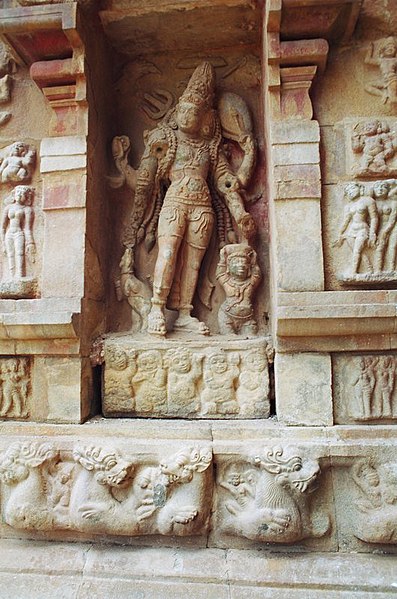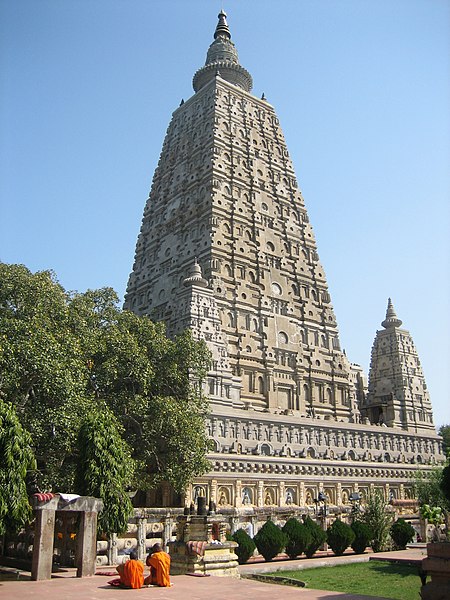Must watch:
The above links are the documentry about chola temples by BBC. Its a very experience
to know best about the temple the life of past decade...
Brihadisvara Temple at Tanjavur
The Brihadisvara temple at Thanjavur was built by the great ruler Rajaraja Chola of the Chola dynasty, and was included as a World Heritage Site in 1987.The 10th century AD site is a brilliant example of Dravidian temple architecture. The central temple called the Periya Koyil, or big temple, stands inside a fort whose walls were built later on in the 16th century. The Vimana, or tower, of the temple is seventy meters high and is the biggest in the world.The Sikaram, or crown, is an octagonal cupola and weighs around eighty-two tones. It was believed to be carved from a single stone, but this theory has since been refuted. The difficult task of raising the seventy meter tower to the top of the temple was achieved by constructing a scaffolding of sand nearly eleven kilometers long. The main deity who has been worshipped here since that time is Lord Shiva in the form of a Shivaling. The Shivaling at Brihadisvara is perhaps the most glorious in existence. With a height of 8.7 meters, it is the largest Shivaling in the world. Another notable feature of the temple is the stone bull Nandi. It is immense in size and the ceiling of its enclosure is covered with beautiful frescoes in the typical Thanjavur style. The Nandi weighs twenty-seven tones and is the second largest in the world. Life size representations of Durga, Lakshmi, Saraswati, and various forms of Shiva like Natesa, and Ardhanariswara adorn the walls and inner passages. Architecturally the temple is the most ambitious structural granite temple to be ever built in the world.The mural paintings of the lower ambulatory side are fine examples of Chola period art. A local Maratha ruler named Sarfoji rebuilt the Ganesha shrine. Later the celebrated Thanjavurstyle of paintings was superimposed over the Chola murals.The temples encouraged fine arts. The sculptures and paintings on the walls of the sanctum and even inscription in elegant Chola and Tamil letters are proof of the artistic and literary progress under Rajaraja. Dance and music were greatly cultivated under the service of the temple. Every evening as part of entertainment and ritual the townspeople gathered at the mandapa, watching the song and dance.
Brihadisvara temple at Gangaikondacholapuram
Another jewel in Chola architecture is the Brihadisvara temple at Gangaikondacholapuram built by the equally illustrious son of Rajaraja Chola, namelyRajendra Chola. The Cholas had just completed successful incursions into northern India, where Rajendra Chola captured the territories of Madurai and Ellum, expanding the Chola Empire to the banks of the River Ganga. Rajendra Chola then collected water from the River Ganga and sanctified his local reservoir with it. With this action he was given the name Gangaikondan, literally meaning “one who brought the Ganges”. Gangaikondacholapuram, located right next to modern Kumbakonam, was established as his capital city. The Gangaikondacholapuram temple was thus built in the golden era of Chola rule, and was an effort by Rajendra Chola to advance the architectural passion of his father. Rajendra Chola wanted to build a temple that equaled the Brihadwisvara temple of Tanjavur in grandeur. The Gangaikondacholapuram temple was built in between 1020 and 1029 AD. The temple is 54.86 meters tall and follows the arrangement of the temple at Thanjavur.Compared to that one, though, this temple is shorter, more graceful and delicate in its contours The temple has intricate carvings on its vimana, or tower, and is influenced by the Northern Chalukya style of architecture. It is built on hard southern granite stone and with the influence of Pallava and Dynasty styles. A ruined gopura, or temple entrance, can be seen at the inner wall of the temple complex. The gopuras of the larger outer walls were pillaged a long time ago. On entering, the huge Nandi or bull can be seen, though it is not a monolithic structure like its counterpart atThanjavur. Some of the outstanding figures of this temple are the figures of Nataraja, or the Dancing Shiva, the coronation of Rajendra Chola by Shiva andParvati, dancing Ganesha, and Ardhanarisa, or half male-half female Shiva. The sanctum contains a five-meter high Shivalingam.Two walls surround the sanctum to provide a private worship space for the royal family. Chalukyan style images of Gods and Goddesses adorn the surrounding walls.The temple also shows the fondness of the Cholas to keep records of their history. Inscriptions are found in plenty on the temple walls. The walls provide different anecdotes such as victories of Rajendra Chola, land grants made during his reign, details of his ascension and many other stories. The temple was to witness many wars after the Chola era. It was used as a garrison and cantonment first by the Pandyas and then by the British. It was also looted on many occasions.
son of Rajaraja Chola, namelyRajendra Chola. The Cholas had just completed successful incursions into northern India, where Rajendra Chola captured the territories of Madurai and Ellum, expanding the Chola Empire to the banks of the River Ganga. Rajendra Chola then collected water from the River Ganga and sanctified his local reservoir with it. With this action he was given the name Gangaikondan, literally meaning “one who brought the Ganges”. Gangaikondacholapuram, located right next to modern Kumbakonam, was established as his capital city. The Gangaikondacholapuram temple was thus built in the golden era of Chola rule, and was an effort by Rajendra Chola to advance the architectural passion of his father. Rajendra Chola wanted to build a temple that equaled the Brihadwisvara temple of Tanjavur in grandeur. The Gangaikondacholapuram temple was built in between 1020 and 1029 AD. The temple is 54.86 meters tall and follows the arrangement of the temple at Thanjavur.Compared to that one, though, this temple is shorter, more graceful and delicate in its contours The temple has intricate carvings on its vimana, or tower, and is influenced by the Northern Chalukya style of architecture. It is built on hard southern granite stone and with the influence of Pallava and Dynasty styles. A ruined gopura, or temple entrance, can be seen at the inner wall of the temple complex. The gopuras of the larger outer walls were pillaged a long time ago. On entering, the huge Nandi or bull can be seen, though it is not a monolithic structure like its counterpart atThanjavur. Some of the outstanding figures of this temple are the figures of Nataraja, or the Dancing Shiva, the coronation of Rajendra Chola by Shiva andParvati, dancing Ganesha, and Ardhanarisa, or half male-half female Shiva. The sanctum contains a five-meter high Shivalingam.Two walls surround the sanctum to provide a private worship space for the royal family. Chalukyan style images of Gods and Goddesses adorn the surrounding walls.The temple also shows the fondness of the Cholas to keep records of their history. Inscriptions are found in plenty on the temple walls. The walls provide different anecdotes such as victories of Rajendra Chola, land grants made during his reign, details of his ascension and many other stories. The temple was to witness many wars after the Chola era. It was used as a garrison and cantonment first by the Pandyas and then by the British. It was also looted on many occasions.Airavatesvara temple at Darsuram
The third temple in this threesome is the Airavatesvara temple built by Rajaraja Chola II. Built at Darsuram, it features a 24-m Vimana and a stone image of Siva. The three temples are a living example of the brilliant art and architecture of the Chola dynasty.The temples are open from 6am to noon and from 4 to 8 pm. No trip to South India is complete without a trip to these Great Living Chola Temples.Importance:
1.The three Chola temples of Southern India represent an outstanding creative achievement in the architectural conception of the pure form of the dravida type of temple.
2.The Brihadisvara Temple at Thanjavur became the first great example of the Chola temples, followed by a development of which the other two properties also bear witness.
3.The three Great Chola Temples are an exceptional and the most outstanding testimony to the development of the architecture of the Chola Empire and the Tamil civilisation in Southern India.
4.The Great Chola temples at Thanjavur, at Gangaikondacholapuram and Darasuram are outstanding examples of the architecture and the representation of the Chola ideology.
For Travel:
----> 55 kms from thrichirapalli airport.
---->163 kms from madurai airport.
---->Travelers can board train or flight to trichy or madurai and get travel to thanjavur but local traval availabilities.
---->Travelers can check the hotel availabilities in Thanjavur or Thrichy or Madurai via online even as per their convinence.
Visual Treat:







Source:
Experience the Dravidian culture from chola temple,Thanjavur...book ur Travel Plans..to know the Tamil culture :) :) :)














